Diving With The Ball Watch Engineer Master II Diver Chronometer
When Ball Watch asked me to test dive one of the company’s newest watches, the Engineer Master II Diver Chronometer, I hesitated a bit. Ball Watch didn’t jingle a diving bell for me, but something else from history jangled. A brand’s “history” section is always the first one I check before testing a watch.
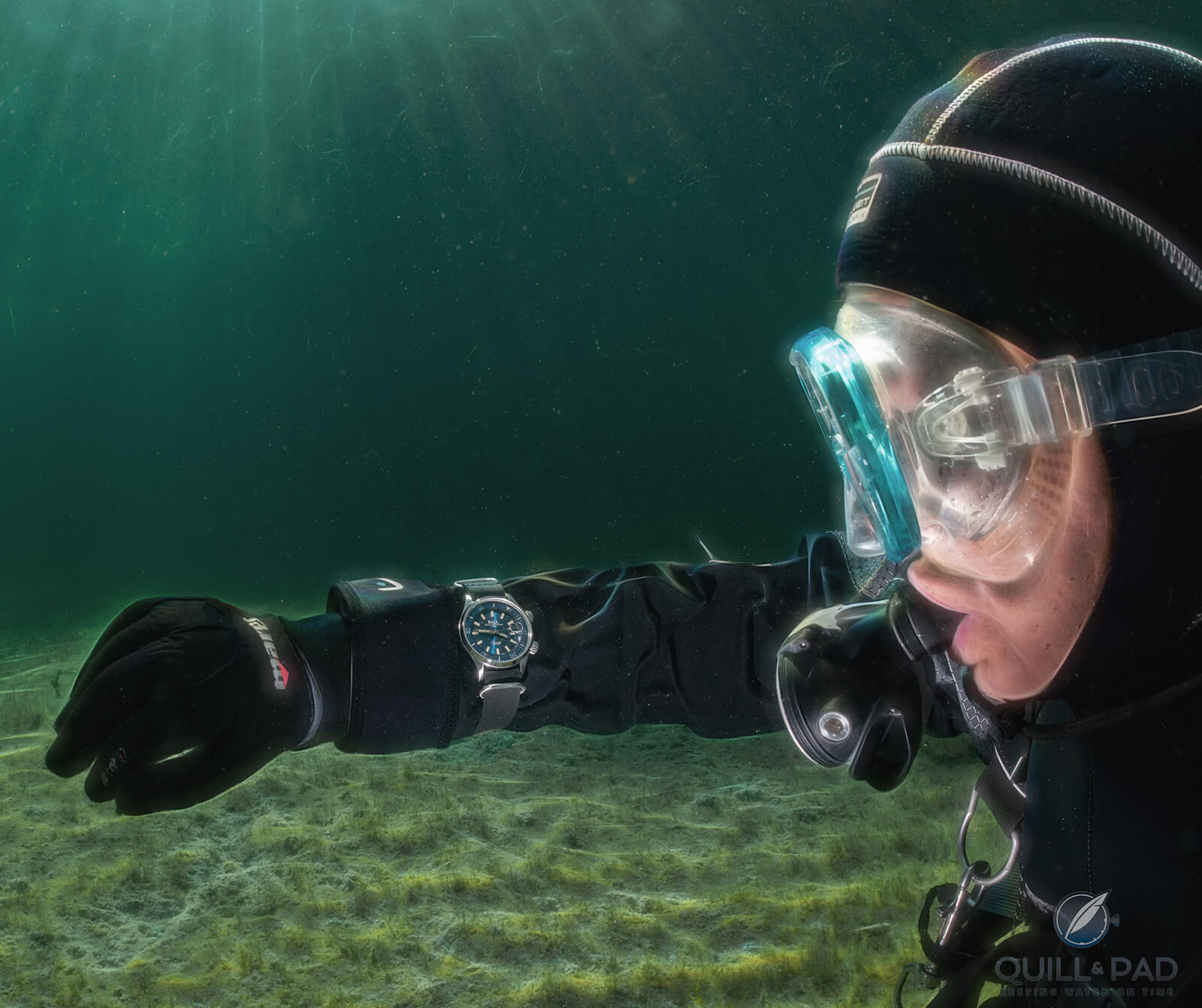
Ball Watch Engineer Master II Diver Chronometer on Dietmar Fuchs’ dive in Austria (photo courtesy Ortwin Khan)
Aside from diver’s watches with their limited histories, there are pilot’s watches, which have enjoyed much more time in history than divers, and railroad watches, which have the longest history connected to technical requirements.
One thing is common to all three of these types of watches: if they are minutes – or even seconds – off, life is threatened.
The 1891 Great Kipton Train Wreck of Ohio, which happened because an engineer’s watch had stopped, is the point generally taken as the impetus for creating a reliable railroad timing system. Webster Clay Ball was appointed chief time inspector of the Lake Shore and Michigan Southern Railways after the tragedy, establishing precision standards (“RR Standard”) and a timepiece inspection system for chronometers used by railroad employees. Ball was an Ohio-born watchmaker and jeweler, and his local business eventually grew into the Ball Watch Company.
Ball reacted quite quickly to make railroads of the late nineteenth century safer. And in the early 1960s the company named for him again moved fast in realizing the same is necessary to make sport diving safe, introducing its diver’s watch to the newly formed sport diving community in the United States. This community was already using the then-recently invented Aqualung to dive to greater depths with its increased risk of decompression sickness.
Only a water- and pressure-tight watch with a separate timing device could assist deep divers in safely controlling their no-decompression dive time if they wanted to go deeper or stay longer – or both – to control the necessary decompression time at different depths, a quite complicated system that I will detail using famous diving watches in upcoming stories.
All in all, this is my kind of history – and one that I expect from a real diving watch, no matter the cost, no matter the appearance. I am the resident diver at Quill & Pad, competent enough to test any self-proclaimed diver’s watch to its limits. I both submit these watches to the same pressures divers experience and explore their history and accomplishments on the wrists of real aquanauts.
And that’s what I did with my dive buddies during the first weekend in October, much later than I wanted to and much later after Ball sent us their latest diving watch. But as you might suspect, Corona is to blame for this.
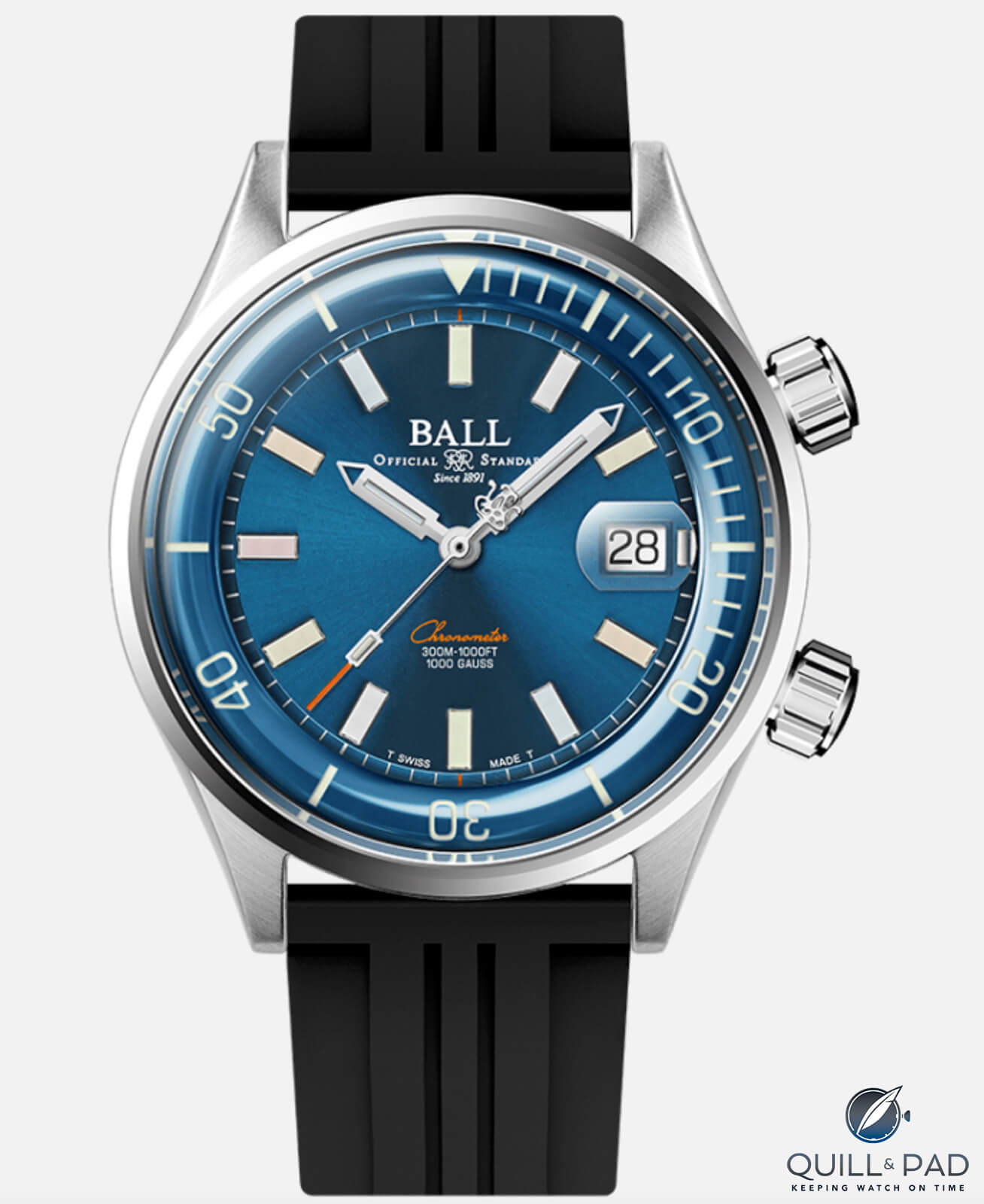
Ball Watch Engineer Master II Diver Chronometer
Testing the Ball Watch Engineer Master II Diver Chronometer
Let`s first have a look at the watch before baptizing it. Stainless steel case with a rubber strap – as expected – but two crowns, one to adjust the time and date and wind the watch and the other to move the inner diving bezel.
All quite normal for a more fashionable diver’s watch that wants to look like a regular watch (rather than tool watch) but features some extra sporty functions for adventures not only on land but in the skies as well as the watery depths. All in all, my kind of watch.
As I’m not a big guy, the 42-millimeter watch looks great on my skinny (for a diver) arms and would, in my opinion, look even better on a female diver’s arm. But I was also thrilled and a bit nervous to test dive it, knowing of the three main problems these kinds of watches could give me once deep down.
Three potential problems in diving with the Ball Watch Engineer Master II Diver Chronometer
The very first problem that I imagined might crop up just by looking at this diver’s watch with its small indices and bezel markings was eliminated the first night I wore the watch. I have rarely seen such tiny indices shine so brightly. This forced me to get up in the night, fire up my iMac, and google Ball Watch.
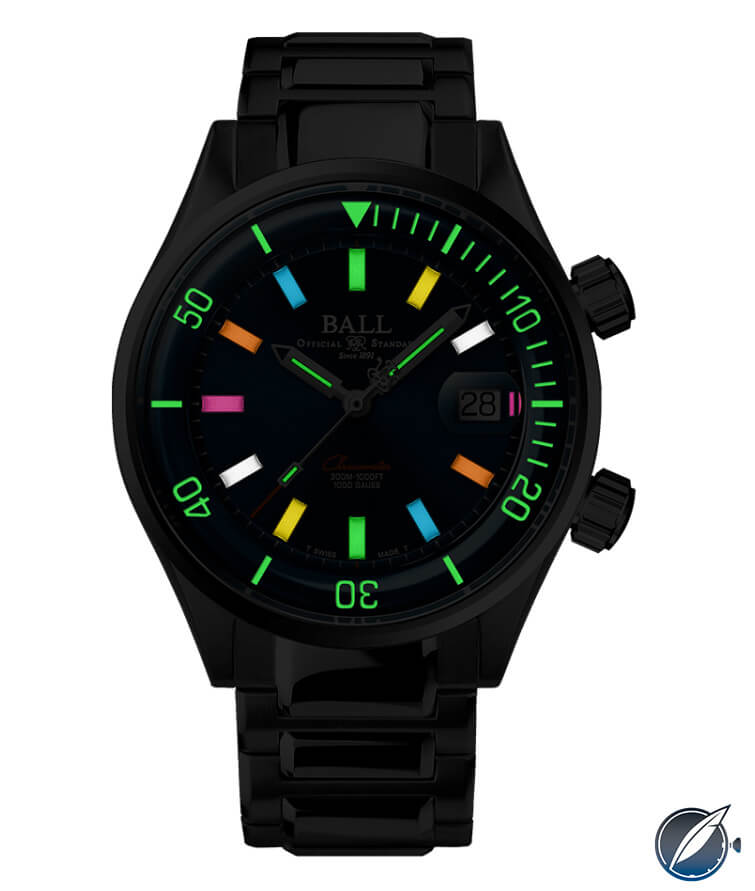
Ball Watch Engineer Master II Diver Chronometer at full lume
Wow, yes, I found the answer: this watch does not use LumiNova or even Super-LumiNova but rather a system of 36 tiny micro gas tubes to illuminate the markings during the night or in the depths of a murky lake. So no problem with the smaller markings that characterize a more fashionable watch but would be out of place on an instrument watch.
Problem number two: no matter which watch I test, they rarely, if ever, have a strap that fits over my drysuit. The best available are those that come with an extension. But rubber straps feature pin buckles, which only work if the band is self-tightening (going down) and self-expanding (going up).
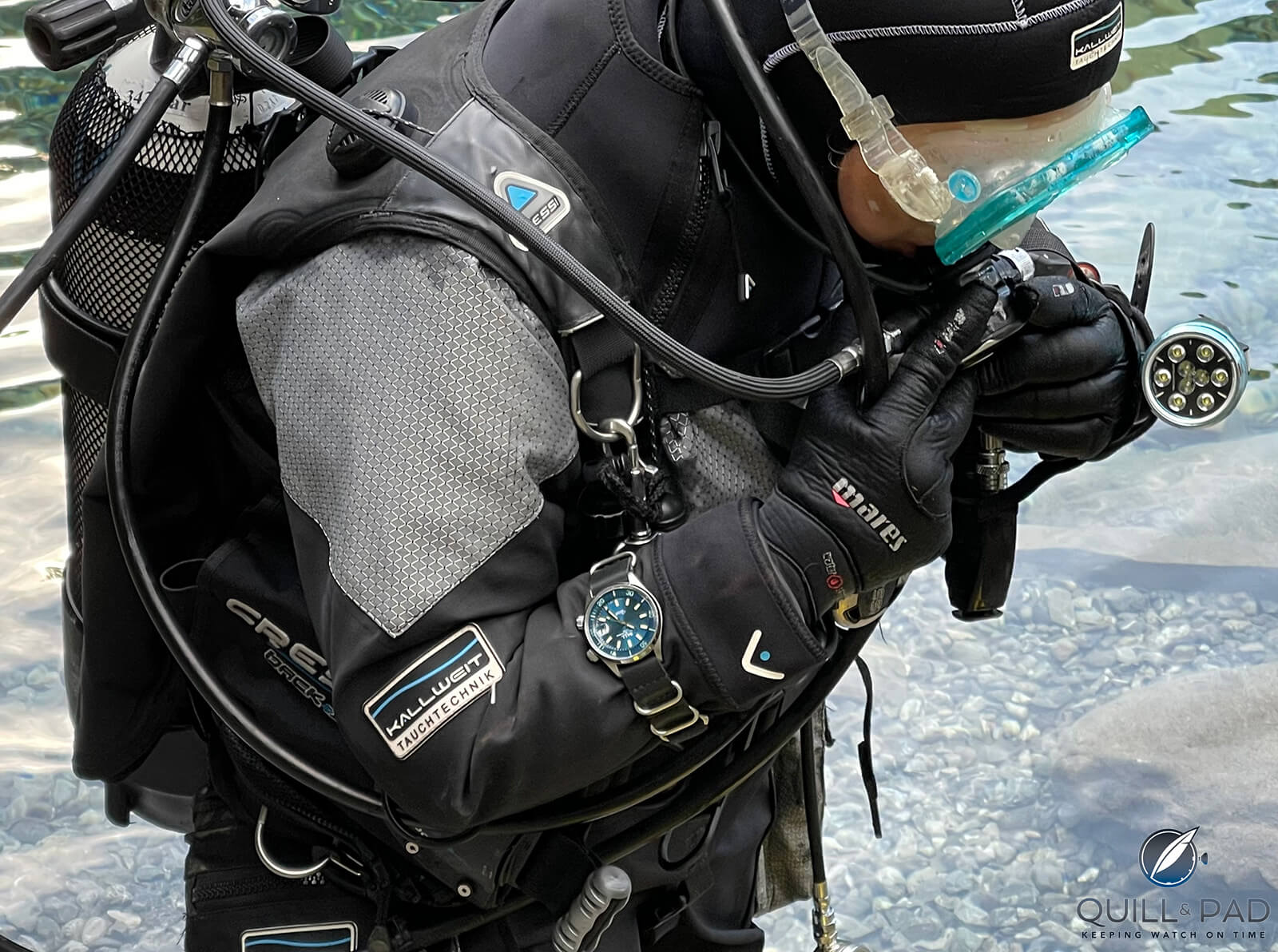
Diving with the Ball Watch Engineer Master II Diver Chronometer (photo courtesy Dietmar W. Fuchs)
If they don’t do this (and I know of none that really do it the way I like) one needs to tighten and loosen it via the buckle. With camera equipment and scooter in hand as I dive this is totally impractical. And that’s exactly why dive computers have Velcro on their wristbands.
Velcro is perfect for diving, but quite ugly on a fashionable wristwatch. And this is the reason why I use leather NATO straps on mine and had one custom made to fit on the Ball Engineer Master II Diver Chronometer I tested. Not a cheap replica with a pin buckle but one with a real double-D ring.
With its steel buckles it even matches the technical appearance of our dive gear, and with the double-D ring for tightening and loosening with one hand, it works for almost all technical divers who want to use instruments on their arms.
And, yes, it took me some time to have a fitting leather wristband manufactured for my Ball Watch test. And I know what you are thinking regarding the leather, but rest assured I use hydrophobic leather that works fine for divers like me. And, yes, specialized wristbands for divers will be another story here on Quill & Pad soon.
Two out of three problems solved ahead of time; the third problem would have to wait until the dive. And the dive had to wait until air filling was possible again, my drysuit was back from maintenance, and we could stay in a nice hotel with lake access (Corona made that impossible for a while).
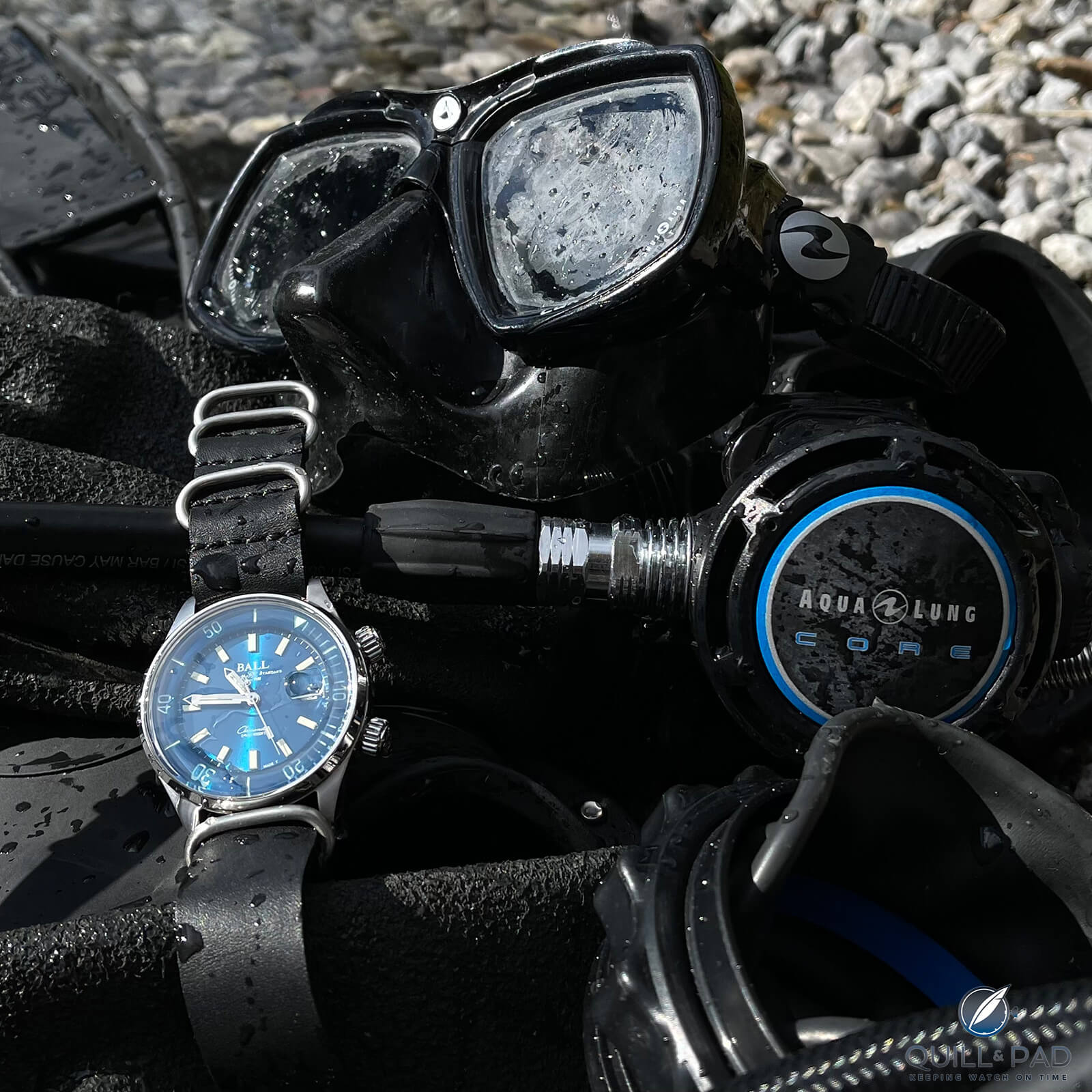
Ball Watch Engineer Master II Diver Chronometer
The dive
For an appropriate surrounding fitting the watch, we chose Schlosshotel Fernsteinsee with its two private Alpine lakes – Fernsteinsee and Samaranger See – both in walking distance from the hotel and both excellent for diving in cold water, picture taking, and providing quite a fashionable setting to show off a luxury watch.
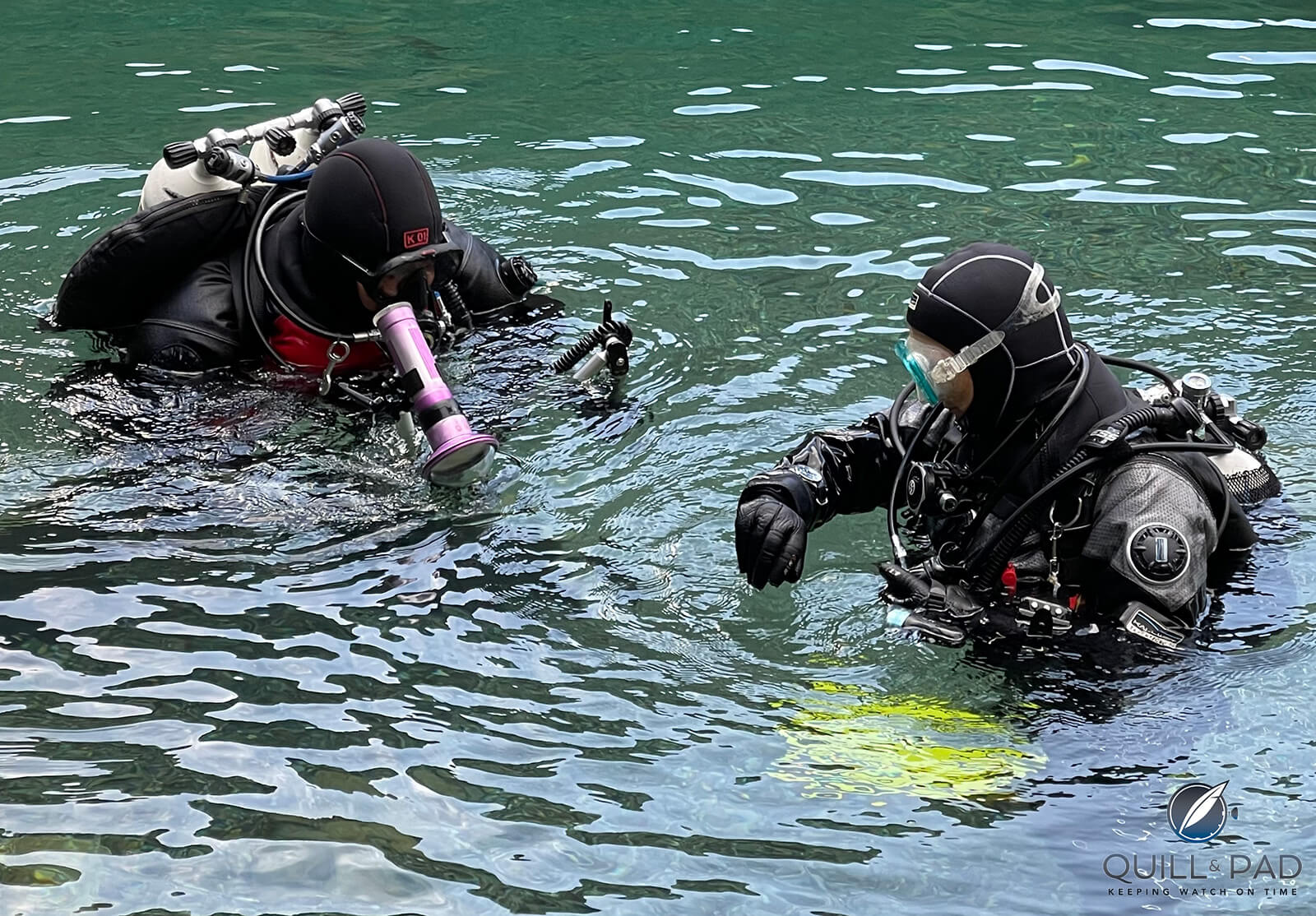
Going down: diving with the Ball Watch Engineer Master II Diver Chronometer (photo courtesy Dietmar W. Fuchs)
This setting was ideal for testing a diver’s watch and documenting the dive. Not good for deep diving, but if a watch remains water resistant in shallow water it will definitely be water resistant in the depths that divers roam. And the lake is cold as it has its own spring. We measured 13°C in late September, which necessitates the full drysuit I would wear going very deep.
Luckily, I was enjoying the lake with some friends and could get Ortwin Khan, one of our best underwater photographers, to take pictures of the watch.
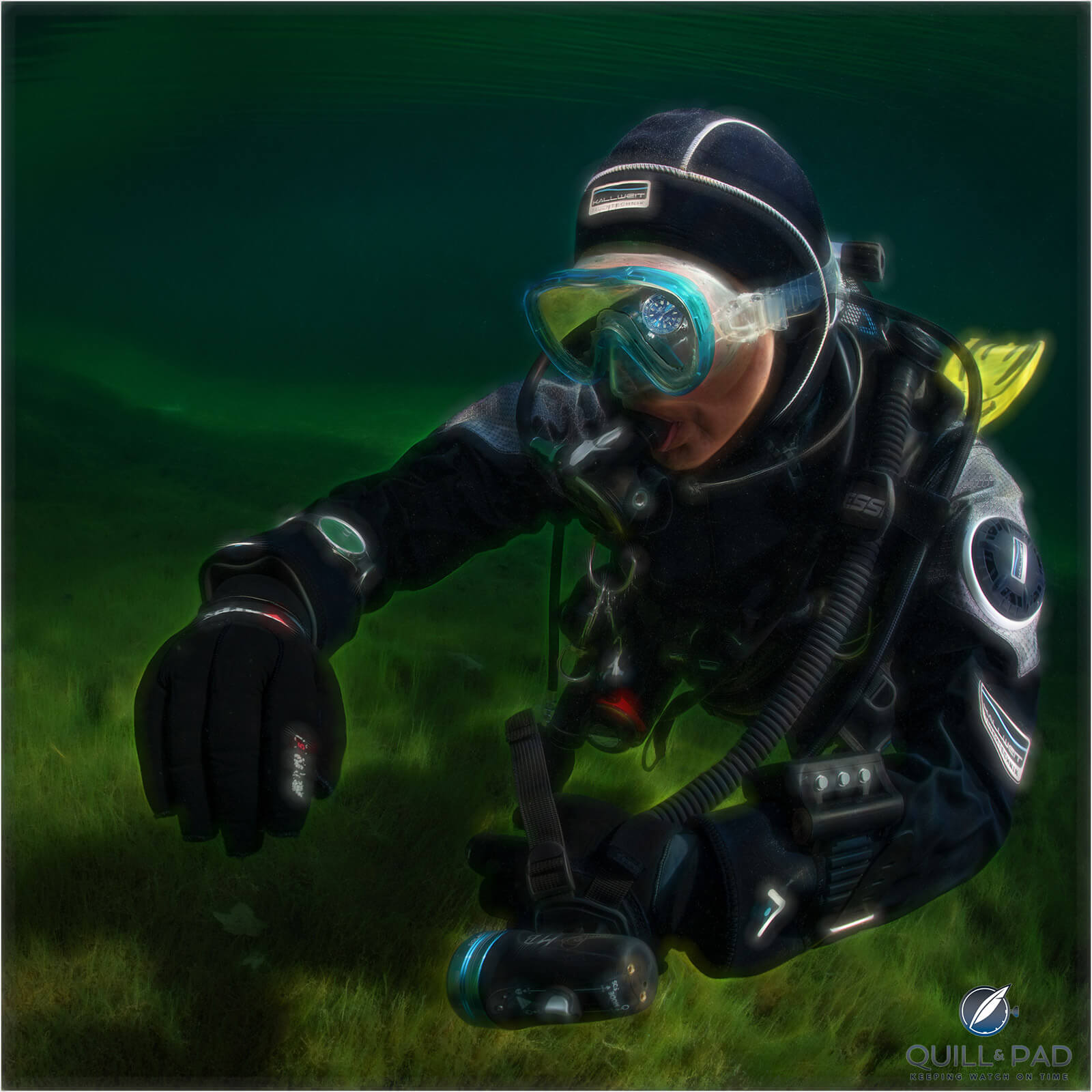
Ball Watch Engineer Master II Diver Chronometer diving in Austria’s Fernsteinsee (photo courtesy Ortwin Khan)
In the end, we could not eliminate the third problem, which I recognized in advance: the bezel is not operable with gloves, neither the neoprene gloves our female tester wore nor my drysuit gloves. If you are seriously using the watch for diving – which is all the fun in using a watch for diving – you would need to move the bezel for marking decompression times (please see The Diving Bezel: The Most Versatile Watch ‘Complication,’ Even If You’re Not A Diver).
That is nearly impossible today anyway with all inside bezels that are moved by tiny second crowns. Which, in the case of this Ball Watch Engineer Master II Diver Chronometer is a shame as the company has already eliminated the problem with its “newly engineered rotating external bezel re-tooled for easier, faster setting and easy wearing – especially with exploration gear – the timepiece now features a rotating external bezel for controlling the inner ring” (quote from company materials).
If you are a technical diver using watches for your dive and love the appearance and – most of all – the history of Ball Watches I might suggest going for the Ball Watch Engineer Master II Diver Worldtime (42 mm). If you are not diving in cold water or use dry gloves, everything else works fine. If you love the appearance of an inner bezel and those two crowns like I do, you can easily use the watch in your dives.
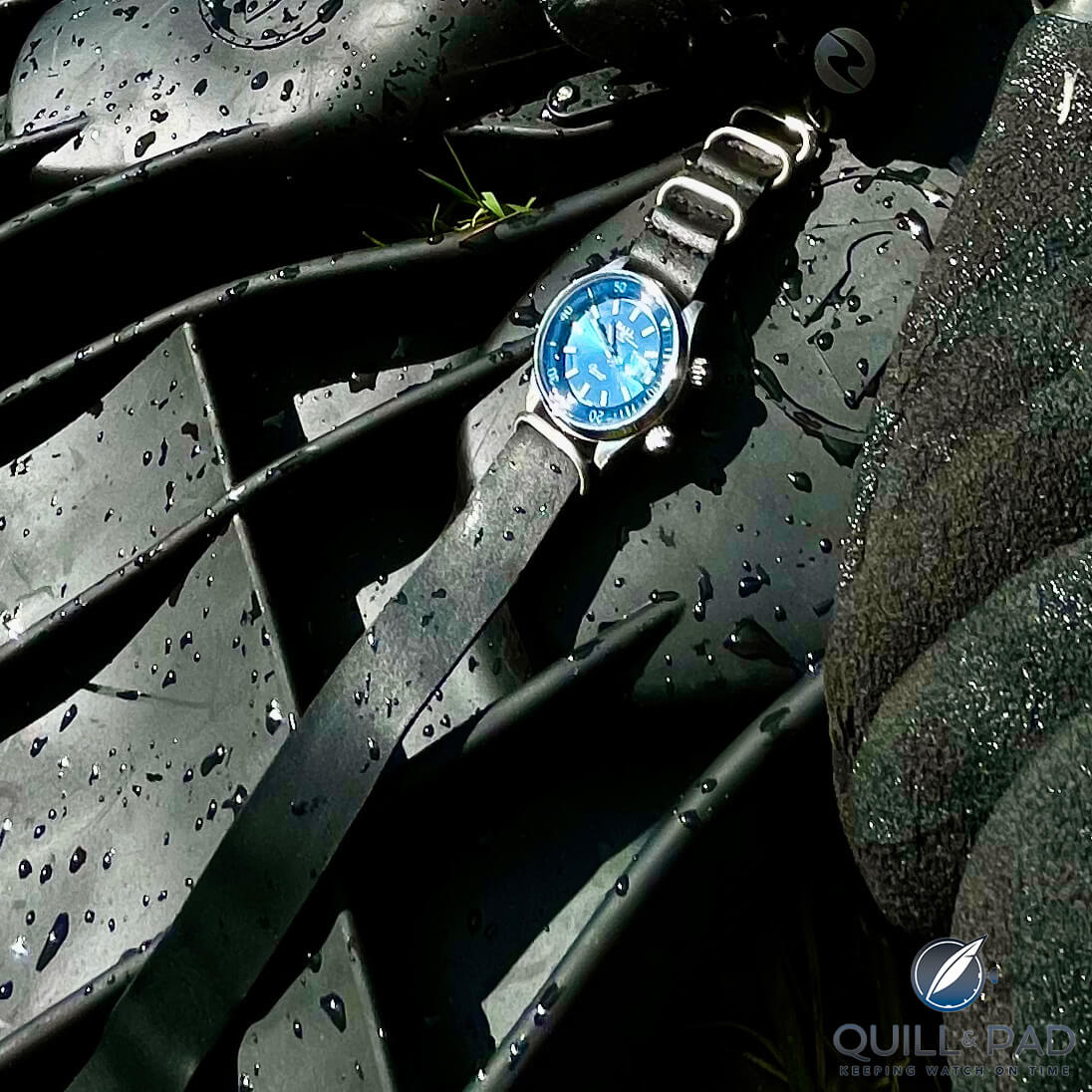
Ball Watch Engineer Master II Diver Chronometer on the rocks
Dive summary
The Ball Engineer Master II Diver Chronometer (why do fine watches need to have such long names?) is an extraordinary diver’s watch for use in sport diving and every day.
Plus, Ball Watch is a company with a real history in engineering diver’s watches.
With its tiny markings, the watch is quite fashionable and does not look like a diving instrument. But it is sturdy and easily readable in all situations, especially in the dark.
Changes I would make would be to add a diveable leather strap (a topic I will write about in my next story).
What I do not need in this watch as a diver is the magnifying loupe over the date or to read the time during the day.
I love inner bezels and like the idea of outside functionality as in the Ball Engineer Master II Diver Worldtime. And the worldtime function (even if it is “hidden” in the bezel) is a very nice feature for divers as we travel a lot in search of the best dive sites worldwide.
Would I use the Ball Engineer Master II Diver Chronometer for everyday diving? Absolutely yes.
For more information on the Ball Engineer Master II Diver Chronometer, please visit www.ballwatch.com/global/1/collections/engineer-master-ii/diver-chronometer.
Quick Facts Ball Engineer Master II Diver Chronometer
Case: 42 x 13.5 mm, stainless steel, bidirectionally rotating inner bezel, screw-in crown, water resistant to 300 m
Movement: automatic Caliber RR1101 (ETA base), shock-resistant to 1,000 Gauss (80,000 A/m), officially C.O.S.C. chronometer certified
Functions: hours, minutes, seconds; date
Price: $2,149
* This article was first published 13 January 2022 at Diving With The Ball Watch Engineer Master II Diver Chronometer
You may also enjoy:
A Comprehensive Look At Mechanical Depth Gauge Watches
The Diving Bezel: The Most Versatile Watch ‘Complication,’ Even If You’re Not A Diver
Blancpain Fifty Fathoms: Story Of The World’s First Diving Watch (Video)
Ball Watch SpringLock Shock Protection Tested By Kiss Drummer Eric Singer
Leave a Reply
Want to join the discussion?Feel free to contribute!



What in my eyes sets Ball apart from other divers is the use of gas tubes. I wonder how visible are Lumininovas when deep diving in murky waters on overcast day not mentioning night dives. You must know the ansver. I do agree that magnifying loupe is unnecessary addition. That goes for all other watches Rolex included but it`s my personal opinion. Last, inner bezel crown. A question to which answer I perhaps overlooked. Is it operable under water, do you have to pullor push the cown to unlock it or it relyes on hard dents? Finally it`s size. I understand that bigge one would spoil the estetics of watch but is it impossible to make a rubber cap to be fitted over crove to make it operable when needed?
Dear Stanislaw,
thanks a lot for your interesting comments. In my opinion no Superluminova beats the gas tubes! But on some watches (I currently dive Blancpains 500 Fathoms) it is bright enough to be seen in murky water. At night dives and/or caves and wrecks one can use the lamp to brighten it up.
Regarding the inner bezel: Its no problem to operate it without gloves so the watch is fine for 95% of all vacation divers. Only in cold water diving with big suits and dry gloves it nearly is impossible to operate the small crown and a rubber extension will not help a lot. If one wants to use a watch for this kind of diving I would NOT suggest the inner bezel operated by a crown. But how many divers are concerned with this kind of problem? Me and probably two others 😉
“A brand’s “history” section is always the first one I check before testing a watch.”
I have no idea why. The product is the product, right there in front of you. Why would It matter what the company did fifty years ago? Innovation should be encouraged.
Dear Tam,
I’m totally with you on the innovation part!
As I have been diving for quite a long time, I have experienced the innovations in diving technology first hand. Especially the changes from oxygen rebreathers to open circuit systems and now back to trimix rebreathers. Every major change in diving technology implies changes in timekeeping and watch manufacturers who have a long tradition in diving implement these changes more practically than companies that are not familiar with our changing requirements. That is why for me the history of diving watches is so important.